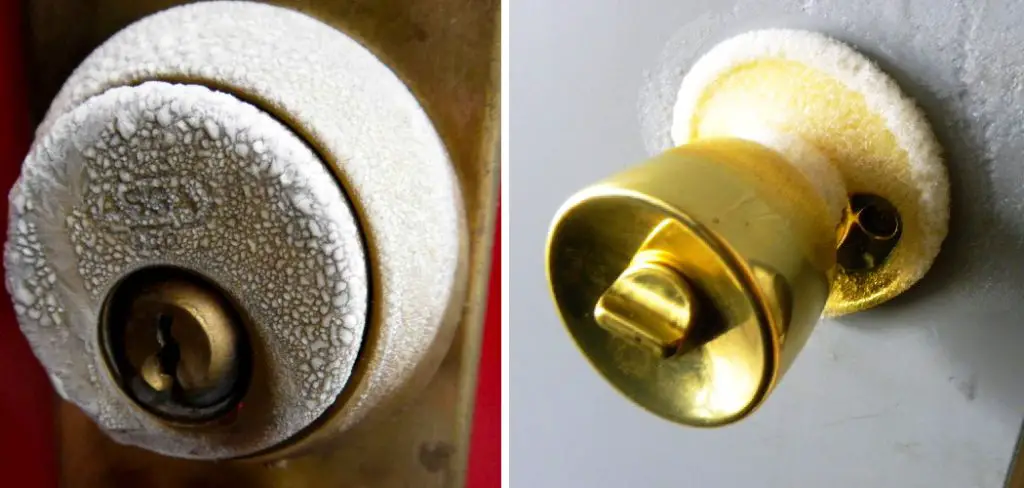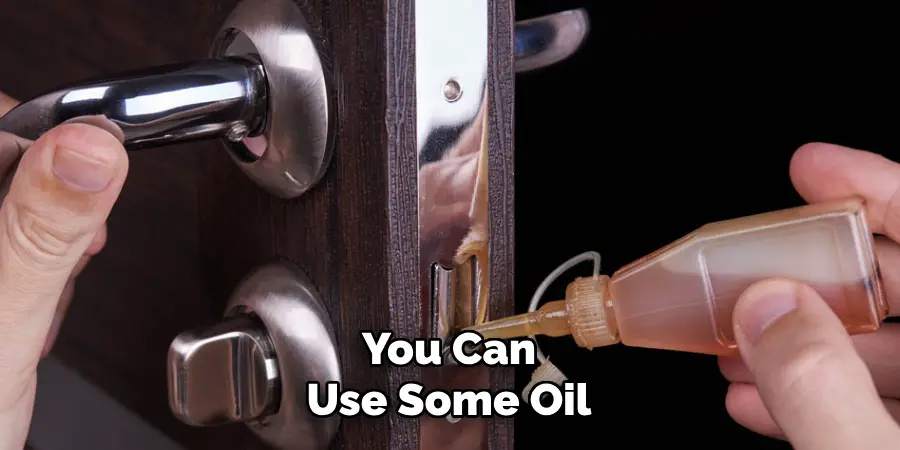Dealing with a frozen house door lock during cold weather can be a frustrating and inconvenient experience. As winter temperatures drop, moisture can seep into locks, causing them to freeze and rendering them inoperable. Learning how to unfreeze a house door lock is a valuable skill that can save you time and frustration.

In this article, we’ll explore effective methods to thaw a frozen lock and regain access to your home. From using specialized lubricants to applying gentle heat, understanding these techniques will empower you to navigate icy lock challenges and ensure smooth entry during winter months.
The Common Issue of Frozen Door Locks during Colder Months
It’s often unpleasant to discover that your house door lock is frozen during colder months. Not only can the cold weather cause ice to form on the outside of the lock, but moisture can also seep in and cause it to freeze. Fortunately, there are a few ways you can unfreeze a house door lock so that you can get back into your home.
The first thing you should do is to apply heat to the lock, in order to melt the ice and thaw out any moisture that has seeped into the mechanism of the lock. This can be done with a hairdryer or heat gun, held at a distance away so as to not damage the plastic or metal components of the lock.
If the frozen door lock is still not responding well to the application of heat, you can try gently tapping around the outer edge with a hammer or other blunt object. This may help break up larger chunks of ice and dislodge any hardened moisture that has built up within.
Finally, if all else fails, consider applying a lubricant like graphite spray or WD-40 to the lock. This can help lubricate the mechanism, allowing it to move more freely and hopefully unfreeze the door lock so that you can get inside your home.
Importance of Maintaining Functional Locks for Home Security
The security of your home or business premises is highly dependent on the functionality of your door locks. It is therefore essential to ensure that all locks are in good working order and well maintained. If a lock becomes frozen due to cold weather, it can be difficult to open the door and get into or out of the property. Fortunately, there are some simple steps you can take to unfreeze the lock and restore it to its proper working order.
The first step is to try and warm up the lock by using a hairdryer or heat gun on a low setting. This should help to thaw out any ice or moisture which has built up inside the mechanism. If this does not work, then you can use some oil or graphite lubricant to help the mechanism move freely. Simply squirt a few drops into the keyhole, wait a minute for it to penetrate, then try inserting and turning the key once again.

If none of these methods work, then you may need to take apart the lock and inspect it for any broken parts. If you find that there is a problem with the internal components, then it may be necessary to call in a professional locksmith who can repair or replace the lock for you.
10 Methods How to Unfreeze a House Door Lock
Method 1: Harness the Heat of Your Key
Embrace the age-old method of utilizing your own body heat. Gently warm your key by holding it in your hands or tucking it into your clothing for a few minutes. The transfer of warmth from your body to the key can aid in melting the ice within the lock, facilitating the turning of the key.
Method 2: Key-Warming via Lighter
Employ a lighter to impart controlled warmth to your key. Briefly expose the key to the lighter’s flame, being cautious not to overheat it. Insert the warmed key into the lock and cautiously turn it to gradually dissolve the ice.
Method 3: Tame the Freeze with a Hair Dryer
Employ a hair dryer set on its lowest heat setting as a gentle thawing agent. Direct the warm airflow directly onto the frozen lock from a safe distance. Be vigilant about avoiding high heat to prevent damaging the lock or its surroundings.
Method 4: The Power of De-Icing Spray
Embrace the convenience of a commercial de-icing spray. Spritz the de-icer directly into the lock’s keyhole, allowing the solution to penetrate and dissolve the ice. After a brief interval, gently attempt to turn the key to unfreeze the lock.
Method 5: Hand Sanitizer’s Helping Hand
Leverage the alcohol content of hand sanitizer as an effective ice-melting agent. Apply a small amount to your key, insert it into the lock, and turn it gingerly. The alcohol’s heat-generating properties will facilitate the thawing process.
Method 6: Rubbing Alcohol for a Gentle Thaw
Harness the power of rubbing alcohol as an ice-melting aid. Like hand sanitizer, rubbing alcohol contains alcohol, which has a lower freezing point than water. Apply a bit to the key and insert it into the lock to initiate the thawing process.

Method 7: Warm Water’s Magic
Draw upon the warmth of water to tackle the frozen lock. Boil water and let it cool slightly until it’s warm but not scalding. Carefully pour the warm water over the lock, directing it into the keyhole to melt the ice.
Method 8: Heat Pack or Warm Cloth Assistance
Enlist the aid of a heat pack or a warm, damp cloth to gradually thaw the frozen lock. Applying gentle heat directly to the lock can facilitate ice melting, and the moisture from the cloth can help loosen any ice within the mechanism.
Method 9: Controlled Warmth with a Heat Gun
A heat gun, set to its lowest setting, can provide controlled warmth to dissolve the ice. Hold the heat gun at a safe distance and direct the gentle stream of warm air onto the lock, being cautious not to subject the lock to excessive heat.
Method 10: Graphite Lubricant for Preventive and Immediate Relief
Harness the power of graphite lubricant not only for immediate relief but also as a preventive measure. Insert the key, then apply graphite lubricant directly into the lock, turning the key several times to evenly distribute the lubricant and prevent future freezing.
Safety Precautions for Unfreezing a House Door Lock
When attempting to unfreeze a house door lock, it is important to always exercise caution and take safety measures. It’s best to leave this job up to a professional locksmith or handyman who can do the work in a safe and effective manner.
Before beginning any work, make sure that you have protective eyewear, gloves, and clothing on to prevent any injury or damage. You should also be sure to wear shoes with proper grip, as you will need to use force when handling the lock mechanism.

It’s always a good idea to have a few spare locks and keys available in case any issues arise during the unfreezing process. Additionally, it is helpful to have a lubricant such as graphite or a silicone-based lubricant on hand to spray the lock mechanism after it’s been unfrozen.
Finally, be sure to step back and examine your work once you have finished the job, to check for any areas that may need further attention or repair. With these precautions in mind, you can successfully unfreeze a house door lock with confidence.
Some Common Mistakes to Avoid When Unfreezing a House Door Lock
When attempting to unfreeze a house door lock, there are some common mistakes that you should avoid if at all possible. It’s important to take the time to ensure that the job is done correctly so as not to damage or further freeze the lock in place.
One mistake that many people make when trying to unfreeze a house door lock is to use excessive force. The amount of pressure and heat needed to unfreeze the lock will vary based on the type of lock, so too much force can actually cause more damage than good. It’s recommended that you use a lock de-icing solution or hot water in order to safely thaw out the frozen parts of the lock.
Another mistake to avoid when unfreezing a house door lock is neglecting the key. Often times the key can be just as frozen as the rest of the lock, and if it’s not properly treated then it can leave you struggling to open your doors. Before attempting to use the key again, make sure to heat it up with a lighter or a hairdryer to soften the metal and give it some lubrication.

Conclusion
All in all, when attempting to unfreeze a house door lock, the home owner needs to carefully assess which method is best suited for their particular lock before proceeding. If done properly, it can be quite simple to unstick the frozen lock and open the door. Though it’s essential to perform the process with caution so as not to damage either the lock or the surrounding door frame.
Of course, it may just be easiest (and safest!) to contact a profession locksmith who can help you open your stuck lock quickly and without any risk of damage. Ultimately, knowing how to unfreeze a house door lock can not only save time and money but also provide vital peace of mind during times of distress. What are you waiting for? Start learning how to navigate these situations yourself if you want a secure home that’s easily accessible!

Swiss watches have long been synonymous with precision. Crafted by legendary artisans, they perfectly unite tradition with innovation.
All elements reflect superior attention to detail, from hand-assembled movements to premium elements.
Investing in a timepiece is more than a way to check the hour. It signifies timeless elegance and uncompromising quality.
Be it a bold statement piece, Swiss watches offer unparalleled reliability that lasts for generations.
http://old.pokvesti.ru/forum/viewtopic.php?f=42&t=433187&p=1205040#p1205040